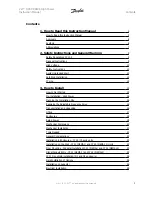
Troubleshooting
48
900-0161-01-01 Rev B
Table 5 Troubleshooting
Symptom
Possible Cause
Possible Remedy
Unusual voltage
on hot or neutral
output line.
System neutral and ground
may not be bonded.
Test
L1
O
UT
,
L2
O
UT
, and
N
O
UT
test points with AC
voltmeter. (See page 45.) These measurements should give
full voltage. Test neutral and ground connections. This
measurement should read zero volts. Any other result means
neutral and ground are not bonded correctly. If this is the
case, the hot line often reads 60 to 75 Vdc and the neutral
reads 45 to 60 Vdc with respect to ground. (If bonding is not
required or is prohibited by national or local codes, then no
action may be required.)
Unusual and
different voltages
on AC hot input
lines.
Input neutral is not connected
correctly. The inverter also
may not connect to the AC
source. Loads may behave
unusually.
Test L1 input and neutral connections with AC voltmeter.
Test L2 input and neutral connections with AC voltmeter.
(This can be on
G
RID
or
G
EN
input, depending on where the
symptoms appear.) Test L1 to L2 input. From hot to neutral
should be approximately 120 Vac unless the output has been
adjusted. L1 to L2 should be approximately 240 Vac. If the
two outputs are different voltages but still add up to 240 Vac,
the neutral is not connected to the inverter.
Inverter has not synchronized
with input source.
System display only:
The
AC In
reading accessed by the
<Inverter>
soft key may be erratic or inaccurate after initial
connection until the inverter has synchronized with the AC
source. This may require a short time.
Loads drop out or
crash during
transfer.
Erratic AC source voltage.
Check AC voltage on the inverter’s input test points. (See
page 45.) If not consistent, the problem is external.
System display only:
AC source voltage may have dipped or
hovered at a low enough point to crash a sensitive load
before the inverter could take over. This can happen if the
inverter’s
Grid AC Input Voltage Limits
or
Gen AC Input
Voltage Limits
were turned down to accommodate a
problematic AC source. To make the inverter respond
sooner, raise the lower limit setting in the appropriate menu.
(If this setting was intentional, then no action is required.)
Inverter set to
Search
(Search mode).
The unit will take a moment to come out of Search mode after
transferring.
System display only:
If constant power is required, set to
ON
with the
INVERTER
hot key. (If this setting was intentional,
then no action is required.)
Loads sensitive to inverter’s
transfer time.
UPS
mode not
in use on the appropriate
input.
System display only:
Most of the input modes feature a small
but noticeable response time during transfer. Certain loads
(such as highly sensitive computers) may not respond well.
The
UPS
mode has a faster response time. Select this mode
for the appropriate input. (See page 16.)
Loads too large.
The unit can transfer more power than it can invert. If loads
are oversized, the unit will falter or crash when switching to
batteries. Reduce the size of the loads.
Undersized battery cables.
Battery cables smaller than recommended will cause a
significant voltage drop when switching to batteries, acting
like either an overload or a low-battery condition. Size all
cables correctly.
Содержание OutBack Power GS4048A
Страница 1: ...Radian Series Inverter Charger GS4048A GS8048A Operator s Manual...
Страница 6: ...Table of Contents 6 900 0161 01 01 Rev B THIS PAGE INTENTIONALLY LEFT BLANK...
Страница 20: ...Operation 20 900 0161 01 01 Rev B NOTES...
Страница 56: ...Troubleshooting 56 900 0161 01 01 Rev B NOTES...
Страница 67: ...Specifications 900 0161 01 01 Rev B 67 NOTES...
















































